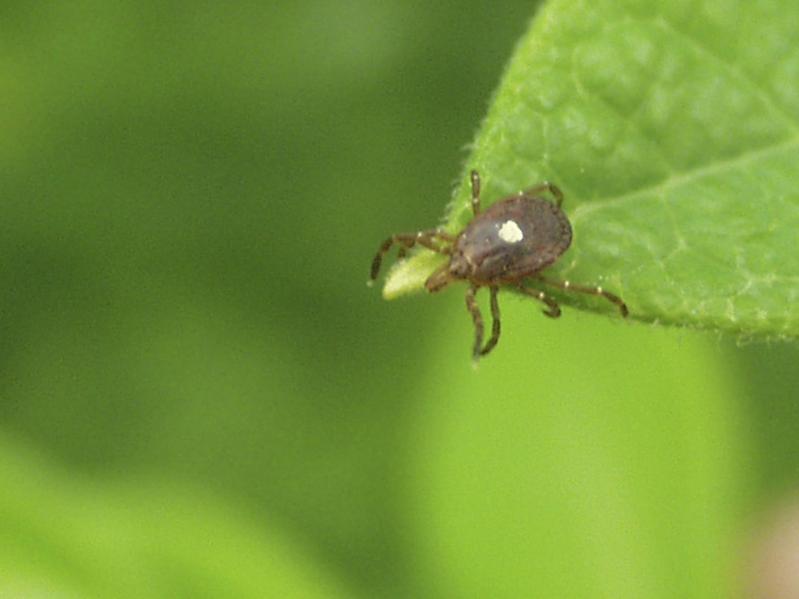The news cycle has provided a bumpy ride recently. Want something nice to talk about on Thanksgiving? Allow yourself to indulge in a little schadenfreude and take joy in the struggles of the hated, the feared, the disgusting, and yes, the misunderstood tick.
According to two Long Island entomologists, the near-complete lack of rainfall between late August and last week may do some real damage to tick populations on the East End. Despite a wet week, It has been the driest autumn on record. The ongoing drought began exactly when larval ticks emerged in August, a worst-case scenario for the little pests. Recent rains likely came too late for them.
Ticks have a three-stage life cycle. The first stage begins when they hatch in late summer as larvae (these larval ticks are often mistakenly referred to as “chiggers”). If they successfully find food (blood), they can survive the winter to emerge as nymph ticks, the second stage, in the spring. Should they find another meal, they can graduate to the third stage, adulthood. They find a host on which to mate, and the cycle begins again. After mating, the adults die. Small consolation as they’ve just created thousands of larval ticks.
The dry fall “will probably have a major effect on tick populations,” said Dan Gilrein, associate agricultural program director for Cornell Cooperative Extension in Suffolk. “Generally, ticks don’t take to dry conditions well. They desiccate fairly easily.”
“It’s unprecedented,” agreed Jody Gangloff-Kaufmann, a Cornell extension associate who also works with the New York State Integrated Pest Management program. “It’s so dry, they probably, especially the larvae, have died off. A good guess is that a lot have perished. However, the lone star tick is much more drought tolerant.”
(Quick caveat: If your property has irrigation that ran through the dry period, you may have helped keep ticks alive that otherwise might have perished. As well, if you’re spraying a pesticide to dry out and kill ticks, watering is effectively rehydrating those same ticks.)
But spraying for ticks may not be as effective as it’s made out to be.
A five-year study by the Cary Institute of Ecosystem Studies and the Centers for Disease Control showed no link between spraying for ticks and a reduction in tick-borne illnesses. “If it doesn’t work to control disease, we should ask why we’re spraying, and not be lulled into a false sense of security that we are protecting our health,” said Dr. Richard Ostfeld, a disease ecologist, Lyme disease expert, and the lead author of the study. “Most sprays are toxic chemicals that can have negative effects on pets, children, pollinators, and even spiders that consume ticks.”
Mr. Gilrein agreed that broadcast spraying for ticks is also killing tick predators. “Ground beetles appear to be a natural predator,” Mr. Gilrein said. “They search through the leaf litter and consume them. I’ve found ticks with bite marks on them.” The insecticide permethrin is highly toxic to bees and wasps, he said, so it kills parasitic wasps, which could otherwise lay their eggs in ticks, killing them before they reproduce. At a symposium on landscaping practices in October, Edwina von Gal, founder of the Perfect Earth Project and a landscape designer, said that spraying ticks was the single worst common landscape practice on the East End. “There is no such thing as a tick-specific spray and we’re living through a massive collapse of biodiversity,” she said.
“We might ignore those costs if we think the benefits are so strong,” Dr. Ostfeld said. “In actual fact, when it comes to human health the benefits of spraying are completely undemonstrated.”
But some methods of controlling tick populations are working. North Haven Village is having great success with its four-poster program. Deer are attracted to feeding stations filled with corn and while they eat, they are painted with permethrin. This method leverages the need for ticks to congregate on their hosts to mate. By directly treating the host, in this case, the deer, instead of spraying, ticks are targeted without collateral damage.
Claas Abraham of the North Haven Village Board, a member of the Suffolk County Tick Advisory Committee, reported a near complete collapse of their population. “In the fall we did a tick drag. We went deep into the woods. We didn’t encounter a single tick.” The four-poster program requires the financial commitment of a municipality, because each unit costs roughly $8,000 annually (North Haven has 20 spread over the peninsula). However, they don’t just reduce tick populations. Their use could help improve water quality, assuming homeowners stop spraying.
In the end, every expert agrees that reducing tick-borne illness comes down to conducting the good old tick-check nightly, especially during the active seasons.
We won’t know until the spring how negatively tick populations have been affected by the drought, but entomologists are optimistic. So, raise that glass over Thanksgiving dinner and toast a less “ticky” spring.




